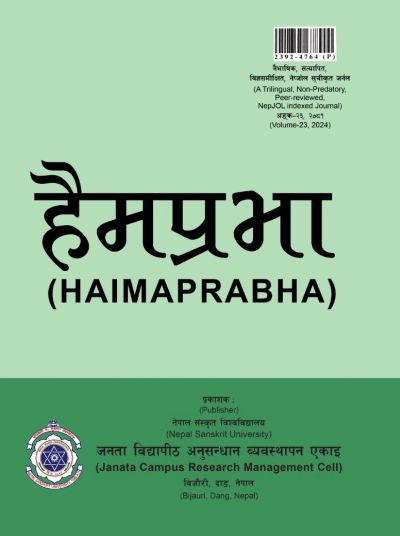'माटो' खण्डकाव्यमा बिम्बविधान
DOI:
https://doi.org/10.3126/haimaprabha.v23i1.66722Keywords:
बिम्बविधान, क्लिष्टता, प्रत्यक्षीकरणपरक, भावावेग, सम्मूर्तितAbstract
प्रस्तुत लेख ‘माटो’ खण्डकाव्यमा बिम्बविधानसँग सम्बन्धित छ । खण्डकाव्यको रचना विधानका कथावस्तु, पात्र, छन्द, लय, प्रतीक आदि विभिन्न संरचक तत्त्वहरूमध्ये एक महत्त्वपूर्ण अङ्ग मानिने बिम्बका दृष्टिले काव्यको अध्ययन तथा विश्लेषण गर्ने यसको उद्देश्य रहेको छ । यसक्रममा संभावनारहित नमूना छनोट पद्धति अनतर्गत उद्देश्यमूलक नमूनाछनोट पद्धतिका आधारमा काव्यकार नारायणकुमार आचार्यको यस कृतिलाई चयन गरिएको छ । काव्यमा बिम्बको प्रयोगबारे अध्ययन गर्दा वर्णनात्मक, विश्लेषणात्मक र तार्किक पद्धतिको प्रयोग भएको छ । प्रत्यक्ष रूपमा कुनै सजीव वा मानवीय पात्रको उपस्थिति नभएर पनि वैचारिक दृष्टिले फरक गरिमा बाकेको यस काव्यको अध्ययनका क्रममा पुस्कालयीय विधिबाट सामग्री सङ्कलन गरी गुणात्मक आधारमा तथ्यको विश्लेषण गरिएको छ । काव्यमा उपलब्ध साक्ष्यहरूमा निहित बिम्बको सत्यापन तथा अर्थापन गरेर तिनको मर्मको अनुशीलन भएको छ । यसक्रममा काव्यमा भएका आलङ्कारिक, प्राकृतिक, ऐतिहासिक, समसामयिक, यथार्थपरक, संवेदनात्मक, पारदर्शी, पौराणिक, सजीव, वौद्धिक, सामाजिक जस्ता बिम्बको सोदाहरण उललेख गरिएको छ । उल्लिखित बिम्बको सशक्त प्रयोगले काव्यको शिल्पपक्ष थप सबल बनेको छ । ‘माटो’ हामी सबैको जनक मात्र नभई पोषक र रक्षक समेत भएकोले यसको श्रीवृद्धिमा समर्पित हुनुपर्ने काव्यको मूलमर्म अभिव्यञ्जित गर्न उल्लिखित बिम्बहरूले विशेष भूमिका खेलेका छन् । यसरी हेर्दा काव्यकार आचार्य आफ्नो मूल कथ्यलाई सजीव रूपमा प्रस्तुत गर्ने कार्यमा विभिन्न बिम्बको प्रयोगमार्फत् सफल भएको निष्कर्ष यस अध्ययनले देखाएको छ ।
[The article explores the Bimbavidhana in Mato Khand Kavya,a great creation of poet Narayan Kumar Acharya. This article focuses on the use of story, characters, rhymes, rhythms and symbols as the dominant characteristics of the Khandakavya. This study also analyzes the specifically subjective use of various images. This text has been selected on the basis of purposeful sampling because the data has been deliberately collected to meet the hypothesis. It is essentially an inductive method that operates through study, observation, examples and analysis. Although there is not the direct presence of any human characters, the Khandakavya carries different norms and values from an ideological point of view. Moreover, the collected data from are analyzed on the qualitative basis. The article verifies and interprets the collected images to find out the message that the poet wants to share with his readers. The soil is not only the mother of all of us, it equally signifies the metaphorical, natural, historical, contemporary, realistic, sensuous, transparent, mythological, living, intellectual, social dimensions.]
Downloads
Downloads
Published
How to Cite
Issue
Section
License

This work is licensed under a Creative Commons Attribution 4.0 International License.
© Nepal Sanskrit University, Janata Campus, RMC, Bijauri Dang, Nepal

